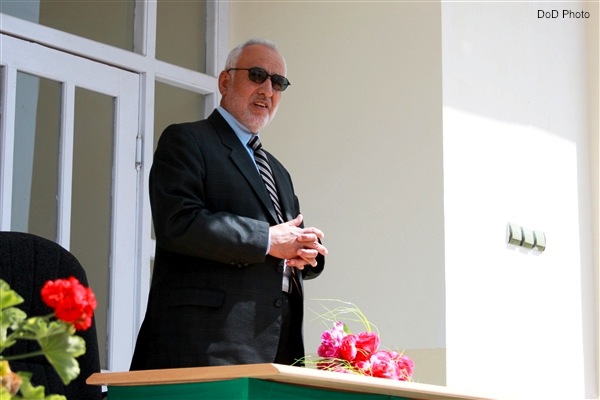
"I am a very favourite whipping boy of America," Gul told the Financial Times. "They can’t imagine the Afghans can win wars on their own."
Gul’s name is at the center of some of the more interesting revelations contained within the leaked papers, specifically with regard to those related to the role of Pakistan’s notorious secret intelligence agency, the ISI, in helping the Taliban.
Until 1989, Gul served as head of the ISI, where he worked closely with the CIA against the then-Soviet occupation of Afghanistan, and is widely believed to have maintained influential contacts with many in the Pakistani military and intelligence establishments.
Following the end of the Soviet occupation of Afghanistan, Gul became virulently anti-American, declaring the War on Terror to be a "war against Muslims" and saying: "Let’s destroy America wherever its troops are trapped."
In the WikiLeaks documents, reports Der Spiegel, "Gul is depicted as an important source of aid to the Taliban and even, in one report, as ‘a leader’ of the insurgents."
The leaked data implicates Gul in ordering suicide attacks and of coordinating a kidnapping plot aimed at capturing United Nations employees on a highway between Kabul and Jalalabad.
But according to the leaked documents, its not just Gul, but the entire ISI that is supporting Taliban and insurgent operations in Afghanistan. "According to the war logs, the ISI envoys are present when insurgent commanders hold war councils — and even give specific orders to carry out murders," Der Spiegel reported.

"Governor Taqwa volunteered the following information," the "Non-Combat Event" report dated "2006-02-06" begins. "There are Taliban (TB) in the Parwan Province…. Hes [sic] known about the Hizbul Mujahideen operating in Afghanistan and has knowledge of them working in the Parwan Province at least for the last two years. He suspects that they … work with TB and Pakistani ISI."
According to GlobalSecurity.org, "Hizb-ul-Mujahideen (HM) is one of the largest terrorist groups operating in Jammu and Kashmir…. It was reportedly formed as the militant wing of the Jamaat-e-Islami (JeI) at the behest of the Inter Services Intelligence (ISI), Pakistan’s external intelligence agency."
In the same 2006 report, Governor Taqwa also supplied information from one of his informants about weapons trafficking. According to that informant, the Taliban were moving a few people at a time into the region "bringing small amounts of weapons and ammunition … to be used on attacks in either Kabul or on Bagram Airfield." According to the informant, "the weapons trail" starts in Parachinar, Pakistan, a city of half a million near the border with Afghanistan that geographers at the University of California, using "standard geographical tools routinely employed to locate endangered species and fugitive criminals," claimed in 2009 was the likely hiding place of Osama bin Laden.
In another report, this time dated "2007-02-25," the Patan District Commissioner, who claimed to be eager to work with U.S. forces because "the Taliban had destroyed his country and now they had a chance because the US was present," said that insurgents "were entering from Pakistan facilitated by Pakistans [sic] ISID" using as a "staging point" the Pakistani village of Mata Sangar. The District Commissioner, who according to the report became considerably more circumspect when pressed for additional information about ISI activity, nonetheless identified the "lead ISI agent staging attacks" from the village of Mata Sangar by name as "Akhtaro, son of Nirbashai."
Regular reports from the Islamic Republic of Afghanistan’s National Police Command Center (IRoA NPCC) also detail purported Pakistani ISI activity, and sometimes allege Iranian activity, in support of insurgents in Afghanistan.
The "NPCC Daily Log" for June 5, 2007 reports from Nuristan that the "Intelligence Department is reporting that the ISI Department of Pakistan has ordered Taliban and other Islamic party members to kidnap foreign citizens from within Afghanistan. They are especially to kidnap India nationals. Once they have been kidnapped, the Taliban or Islamic group is to take pictures or video and then kill the hostages."
The same NPCC Daily Log also notes in another brief report that "the Iranian Government has established a training center for the Taliban in the Saman Abad area."
For its part, Pakistan denies supporting the Taliban and other insurgents in Afghanistan, even though it was the ISI, as former UN deputy special representative for Afghanistan Peter Galbraith notes in the London Guardian, that "helped create the Taliban."
Former ISI chief Hamid Gul also denies any involvement. "Report of my physical involvement with al Qaeda or Taliban in planning attacks on American forces is completely baseless," he told the Wall Street Journal.
And the clear collusion between Pakistan’s ISI and insurgents in Afghanistan has not been an impediment to closer ties between the United States and Pakistan. According to the Wall Street Journal, the CIA and the ISI have agreed to set up new listening posts in Karachi, and one U.S. official told that paper: "There’s a team of crack ISI and CIA people there now."
But, according to the unnamed official, there remains an awareness that all may not be as it seems with the ISI. "Everyone’s eyes are wide open," he said.
Related articles:
Defense Secretary Gates “Mortified, Appalled” by Wikileaks Exposure
Who’s at Fault if WikiLeaks Endangers Innocents?
WikiLeaks.org Releases More Than 90,000 Afghan War Secret Documents


